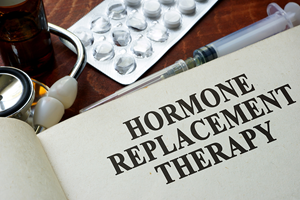The Pill Or The Patch? Are All Estrogens The Same?
 Picture this scenario. You are 55 years old, three years into menopause, with hot flashes, mood swings, and vaginal dryness and pain on intercourse. Your care provider suggests hormone replacement therapy (HRT). However, he recalls that in 2002, the Women’s Health Initiative (WHI) reported that of 10,000 women‐years, HRT produced 18 more women with blood clots, eight more with stroke, and seven more with heart attacks than those not on hormones. You have a family history of blood clots. You hesitate; is this for you?
Picture this scenario. You are 55 years old, three years into menopause, with hot flashes, mood swings, and vaginal dryness and pain on intercourse. Your care provider suggests hormone replacement therapy (HRT). However, he recalls that in 2002, the Women’s Health Initiative (WHI) reported that of 10,000 women‐years, HRT produced 18 more women with blood clots, eight more with stroke, and seven more with heart attacks than those not on hormones. You have a family history of blood clots. You hesitate; is this for you?
Advances in hormone therapy have helped explain many of the adverse vascular outcomes of the WHI. This study compared women on no hormones to those on PremPro®, made up of Premarin®, which is a mixture of estrogens from extracts of pregnant mare’s urine, and Provera®, which is medroxyprogesterone acetate, a synthetic derivative of progesterone. For women with a prior hysterectomy, Premarin® alone was given. Both hormone‐treated groups showed increases in blood clots and stroke. Why?
Our blood is designed to deliver oxygen and nutrition to our cells within a careful balance of biologic factors that normally keep our blood “fluid” under the influence of protein C, protein S, and thrombomodulin. When bleeding occurs, substances released at the site of bleeding activate events to form a clot which eventually must be broken down (lysed) to restore circulation.
How is this done? When hemorrhage occurs, platelets initially drawn there by release of von Willebrand factor and collagen from the injury site plug the defect. Then, at the site of injury, other tissue factors convert prothrombin to thrombin. In turn, thrombin converts fibrinogen, normally soluble in our blood, into a mesh to form a stable clot. Once hemorrhage is stopped, plasmin, produced by release of tissue plasminogen activator, begins to dissolve the clot and restore circulation.
So how does estrogen influence this process? It seems that when Premarin® is ingested as a pill, it is absorbed in the gut and then passes through the liver. This “first pass” in the liver produces a range of other steroids, but also may increase the risk of clotting. Some have proposed that this “first pass” through the liver alters the balance of prostacycline (a vasodilator) and thromboxane A2 (a vasoconstrictor) or reduces the effectiveness of protein C to keep blood fluid.
In contrast, transdermal estrogen patches, which were first studied in 1997, deliver pure estradiol slowly through the skin that is then absorbed directly into the bloodstream. Because of this slow, steady, delivery rate, mimicking to some extent how the ovaries functioned during reproductive years, a lower sustained estrogen dose achieves equivalent biologic effects as those of higher dose estrogen pills. While studies are not as numerous as with oral pills, a consistent conclusion is that transdermal estrogen does not involve a “first pass” and does not change the normal balance of coagulation and anticoagulation factors, thus decreasing blood clotting risk.
In a recent national journal, Menopause, a thorough review concluded that transdermal estrogen does not increase blood clotting risk as does oral estrogen. Perhaps HRT is for you but in a more modern form.
By James Woods, M.D.
Dr. Woods treats patients for menopause at the Hess/Woods Gynecology Practice.
Disclaimer: The information included on this site is for general educational purposes only. It is not intended nor implied to be a substitute for or form of patient specific medical advice and cannot be used for clinical management of specific patients. Our responses to questions submitted are based solely on information provided by the submitting institution. No information has been obtained from any actual patient, and no physician-patient relationship is intended or implied by our response. This site is for general information purposes only. Practitioners seeking guidance regarding the management of any actual patient should consult with another practitioner willing and able to provide patient specific advice. Our response should also not be relied upon for legal defense, and does not imply any agreement on our part to act in a legal defense capacity.
James Woods | 9/8/2014




